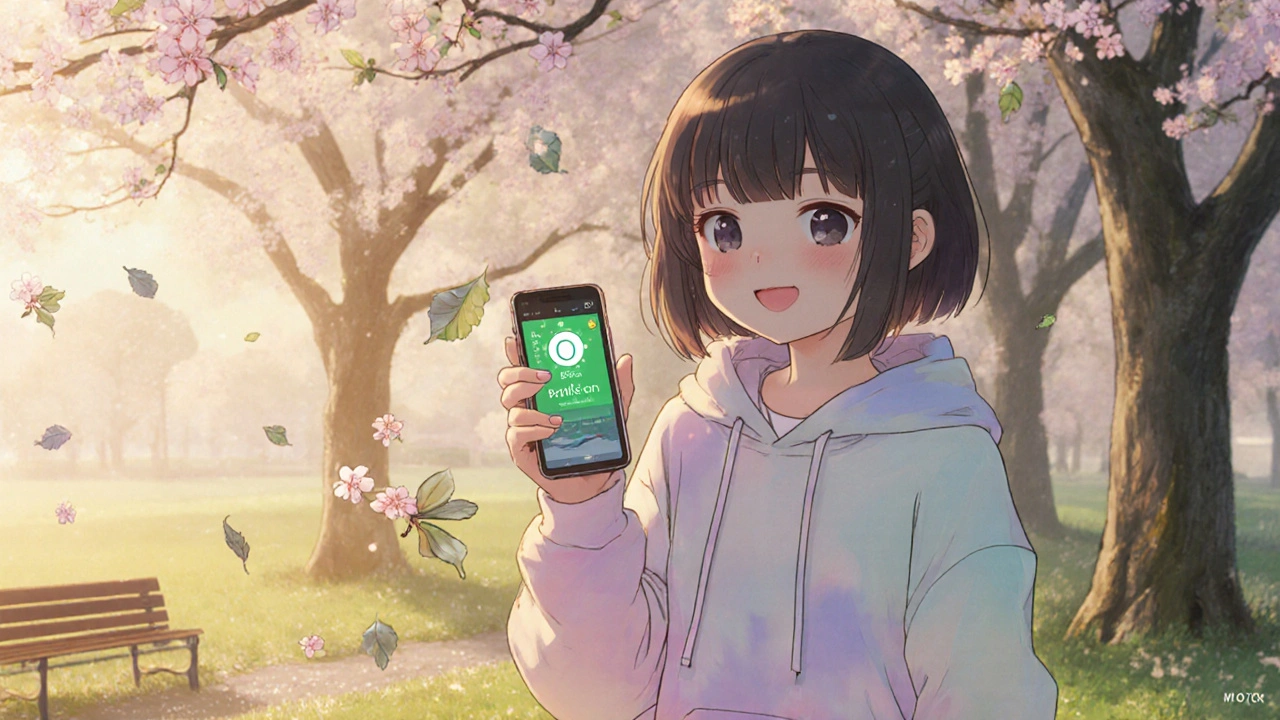Know When to Stay Inside: How Pollen Forecasts Help You Enjoy the Outdoors
If you’ve ever sneezed through a spring walk or woke up with itchy eyes after a sunny afternoon, you know how pollen can ruin your day. It’s not just about feeling uncomfortable-it can keep you from running, gardening, or even playing with your kids outside. The good news? You don’t have to guess when it’s safe to go out. Pollen forecasting gives you real, actionable data to plan your outdoor time around the worst days.
Back in the 1950s, pollen counting was done by hand-scientists used greased rods to catch airborne grains and counted them under microscopes. Today, it’s a high-tech science. Systems like BreezoMeter and the Copernicus Atmosphere Monitoring Service use weather patterns, satellite data, and machine learning to predict pollen levels down to the neighborhood level. These forecasts aren’t perfect, but they’re accurate enough to help you avoid the worst of it.
How Pollen Counts Work: Low, Moderate, High, and Very High
Pollen isn’t measured in vague terms like “a lot” or “a little.” It’s counted in grains per cubic meter of air. Here’s what those numbers mean in practice:
- Low (≤50 grains/m³): Most people won’t notice symptoms. Safe for outdoor activities.
- Moderate (51-149 grains/m³): Sensitive individuals may start feeling itchy eyes or sneezing. Limit prolonged exposure.
- High (150-499 grains/m³): Symptoms are likely for allergy sufferers. Plan indoor activities if possible.
- Very High (≥500 grains/m³): Even mild allergy sufferers will struggle. Stay indoors, close windows, and run your air filter.
Some pollens, like ragweed, are more potent. In the U.S., just 20 grains/m³ of ragweed is considered high. That’s why knowing your local allergens matters more than the general number.
When Pollen Hits Its Peak: Seasonal and Daily Patterns
Pollen doesn’t just show up randomly. It follows a strict calendar-and a daily rhythm.
Seasonal timing:
- Tree pollen: Peaks from late February to late April. In Perth, that’s mostly from eucalyptus, oak, and pine.
- Grass pollen: Hits hardest in May and early June. This is the biggest trigger for hay fever in Australia.
- Weed pollen: Starts in August and lasts until frost. Ragweed, plantain, and nettle are the main culprits.
Daily timing:
- 5-10 AM: Tree pollen peaks as dew dries and winds pick up.
- 10 AM-4 PM: Grass pollen is at its worst-especially on hot, dry days.
- 4-8 PM: Weed pollen rises as temperatures cool and air currents shift.
The safest times to be outside? Early morning (5-7 AM) and evening (7-9 PM). Pollen counts drop by 30-50% during these windows. Runners and parents planning kids’ playtime swear by this.
Weather Rules: Rain, Wind, and Heat Change Everything
Forecasting isn’t just about pollen-it’s about weather. A single rainstorm can cut counts in half. But a dry, windy day? That’s a nightmare.
- Rain: A 0.1-inch shower reduces pollen by 30-50% within two hours. Use it as your green light to go out-just wait an hour after the rain stops so the air settles.
- Wind: Winds over 10 mph can lift pollen from distant fields and blow it into your backyard. If the forecast says gusts above 15 mph, assume counts will spike.
- Temperature: A 2-3°C rise can push pollen levels up by 15-20%. Hot days = more pollen. Cold nights = less.
- Humidity: Low humidity (below 40%) makes pollen lighter and easier to float. High humidity weighs it down.
That’s why checking the weather app isn’t enough-you need a pollen-specific forecast. A sunny 25°C day might look perfect for a picnic, but if the pollen count is 600 and the wind is from the east, you’re setting yourself up for a bad afternoon.

Best Tools for Pollen Forecasts: Free vs. Paid
You don’t need to pay for a good forecast. But not all free apps are created equal.
Free options:
- Pollen.com: Covers the U.S. and parts of Europe. Tracks 10 pollen types. Accuracy: 75%. Resolution: 10km. Good for general planning.
- WeatherBug: Integrates with local weather stations. Better for urban areas. Accuracy: 78%.
- ECMWF/Copernicus: Scientific-grade data for Europe. Free, but no mobile app. Best for detailed regional trends.
Paid/high-end tools:
- BreezoMeter: Uses 200+ data points, including traffic, land use, and satellite imagery. Accuracy: 82%. Resolution: 1.5km. Works with Apple Health. Costs a few cents per API call-free for users via apps.
- Apple Health + BreezoMeter: Now links your pollen exposure to heart rate, sleep, and symptom logs. If you’ve been sneezing every day at 3 PM, it’ll show you the correlation.
In Perth, where eucalyptus dominates, local accuracy matters. BreezoMeter’s hyperlocal data is worth it if you’re serious about avoiding flare-ups. But for most people, checking two free sources-like Pollen.com and your local weather service-is enough.
How to Use Forecasts Like a Pro
Just looking at a number won’t help if you don’t know how to act on it. Here’s how to make forecasts work for you:
- Check two sources daily during peak season. One might miss a local spike.
- Time your activities for early morning or evening. Avoid midday, especially on windy days.
- Combine with weather. If rain is coming, wait an hour after it stops before going out.
- Track your symptoms. Use a notebook or app. If you notice you react badly on days with 180 grass pollen, you’ll know your personal threshold.
- Don’t trust one day’s forecast. Pollen can shift fast. Look at the 3-day trend. If counts are rising, assume tomorrow will be worse.
One user on Reddit, u/AllergyWarrior89, cut their antihistamine use in half just by moving their runs from 6 PM to 7 AM. That’s the power of timing.
What Pollen Forecasts Can’t Predict (And How to Stay Safe)
Forecasts are powerful, but they’re not magic. There are blind spots:
- Thunderstorm asthma: In Melbourne (2016), a storm caused pollen grains to burst into tiny particles that went deep into lungs. Thousands ended up in hospitals-even people who’d never had asthma before. No forecast saw it coming.
- Localized stirring: Mowing your lawn, raking leaves, or even walking through tall grass can kick up pollen that wasn’t airborne before. Forecasts can’t track your backyard.
- Urban microclimates: Pollen levels can vary by 300% between your front yard and the park three blocks away. Only BreezoMeter and WeatherBug account for this.
So what do you do?
- Wear sunglasses and a hat outdoors to block pollen from your eyes and hair.
- Shower and change clothes after coming inside.
- Keep windows closed during peak hours and use air conditioning with a HEPA filter.
- Don’t hang laundry outside during high pollen days-it collects grains like a net.
These small habits add up. A 2023 study found that people who combined forecasts with these practices reduced their allergy symptoms by up to 65%.

The Future: Satellites, AI, and Personalized Alerts
Pollen forecasting is getting smarter. In 2025, the European Space Agency is launching PollenSat-a satellite designed to map pollen types from space. AI models are being trained to predict thunderstorm asthma by spotting atmospheric instability before it happens. And apps are learning your personal triggers: if you react badly to eucalyptus but not to grass, your phone will stop warning you about grass pollen and focus only on what matters to you.
Climate change is making this more urgent. Since 1990, the pollen season in the U.S. has grown by over 20 days, and concentrations have jumped 21%. In Australia, warmer winters mean tree pollen starts earlier and lasts longer. We’re not going back to the old normal.
The tools are here. The data is reliable. The only thing left is for you to use it.
Frequently Asked Questions
How accurate are pollen forecasts?
Most modern systems like BreezoMeter and Copernicus are 80-85% accurate for 1-2 day forecasts. Accuracy drops to 65-70% for 5-day predictions. They’re best for spotting trends, not exact numbers. For daily planning, check the forecast every morning.
Can I trust free pollen apps?
Yes, if you use two of them. Pollen.com and WeatherBug are reliable for general use. But they don’t show hyperlocal data. If you live near a park or field, your actual exposure might be higher than the app shows. Cross-check with local weather stations or university allergy reports if available.
What time of day is pollen lowest?
Pollen is lowest between 5-7 AM and 7-9 PM. Tree pollen drops after sunrise, grass pollen falls after sunset, and weed pollen settles in the late evening. Avoid the midday window (10 AM-4 PM) if you’re sensitive.
Does rain really help reduce pollen?
Yes, but not instantly. A light rain (0.1 inch or more) washes pollen out of the air and reduces counts by 30-50% within 2 hours. Wait at least an hour after the rain stops before going out-wind can stir up wet pollen as it dries.
Why do I still have symptoms on a "low" pollen day?
You might be reacting to a different pollen type than the forecast shows. Or it could be indoor allergens like dust mites. Also, pollen can be stirred up by lawn mowing, gardening, or walking through grass-even if the forecast says it’s low. Track your personal triggers and adjust your habits accordingly.
Should I use allergy medication with forecasts?
Yes, but strategically. Take antihistamines the night before a high-pollen day, not in the morning. That way, the medication is already in your system when exposure happens. Don’t wait until you’re sneezing-use the forecast to prevent symptoms, not just treat them.
Next Steps: Start Planning Your Week
Don’t wait for your next bad day to act. Open a pollen forecast app today. Look at the next 3 days. Pick one day with a low or moderate count. Plan a walk, a picnic, or a bike ride. Do it early morning. Notice how you feel. Then compare it to a high-pollen day you’ve already had. You’ll see the difference.
Pollen forecasting isn’t about avoiding the outdoors. It’s about reclaiming them-on your terms. With the right info, you can enjoy the sun, the breeze, and the greenery without paying the price in sneezes and swollen eyes.


Melvina Zelee
November 24, 2025 AT 00:05i used to hate spring until i started checking pollen counts like i check the weather. now i plan my runs for 6am like it’s a sacred ritual. no more sneezing fits on the trail. also, showering after being outside? game changer. why didn’t i do this sooner?
steve o'connor
November 25, 2025 AT 03:42the rain tip is gold. i live in cork and last week i waited an hour after a shower to go for a walk. felt like i’d been granted a miracle. pollen was basically gone. now i check the forecast and the rain app together. it’s like having a cheat code for sanity.
Robin Johnson
November 25, 2025 AT 17:24if you’re still guessing when to go outside, you’re wasting your health. this isn’t optional advice-it’s a survival tactic. use the 3-day trend. don’t just look at today. if it’s climbing, assume tomorrow’s worse. and yes, your windows stay shut. no exceptions. your lungs will thank you.
Latonya Elarms-Radford
November 27, 2025 AT 08:35oh honey, let me tell you-pollen isn’t just an allergen, it’s a metaphysical metaphor for the fragility of human existence. we are but dust in the wind, and yet we dare to step outside, believing we can control nature’s silent, sneeze-inducing symphony. the trees, they whisper ancient truths in airborne spores… and we? we scroll through apps like children clutching talismans against the inevitable. breezometer? apple health? these are not tools-they are modern-day oracles, whispering to us in binary, begging us to surrender to the rhythm of the earth. and yet… we still mow our lawns at noon. tragic. profoundly, tragically human.
Mark Williams
November 27, 2025 AT 11:54hyperlocal data ingestion via multi-source fusion architecture is critical for individualized exposure mitigation. copernicus provides baseline atmospheric resolution, but breezometer’s edge lies in its spatiotemporal granularity-1.5km grid resolution, cross-referenced with land-use vectors and microclimate modifiers. if you’re not leveraging this, you’re operating on 1990s-era heuristics. also, pollen saturation thresholds are non-linear; 20 ragweed grains/m³ isn’t just ‘high’-it’s a biohazard event for T2-TH2 responders.
Daniel Jean-Baptiste
November 28, 2025 AT 08:36thx for this, really helpful. i live in vancouver and just started using pollen.com + local weather. noticed my eyes stop itching if i go out after rain. also, i forgot to mention-dont hang laundry out. learned that the hard way. my shirt had pollen like confetti. oops.
Ravi Kumar Gupta
November 28, 2025 AT 16:27in india, we dont have fancy apps-but we know this in our bones. when the neem trees bloom in february, everyone stays inside. grandma says: 'if the wind smells like dry leaves, dont step out.' no satellite needed. just wisdom passed down. still, i love that tech is catching up. but dont forget: the real forecast is your body. if you feel itchy before the app says so? trust yourself.
Rahul Kanakarajan
November 29, 2025 AT 05:00you people are overcomplicating this. just stay inside. thats it. no apps, no science, no ‘strategic antihistamines.’ if you’re allergic, be a coward. it’s not a personality flaw. its biology. and stop mowing your lawn. your neighbors hate you anyway.